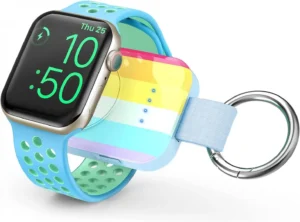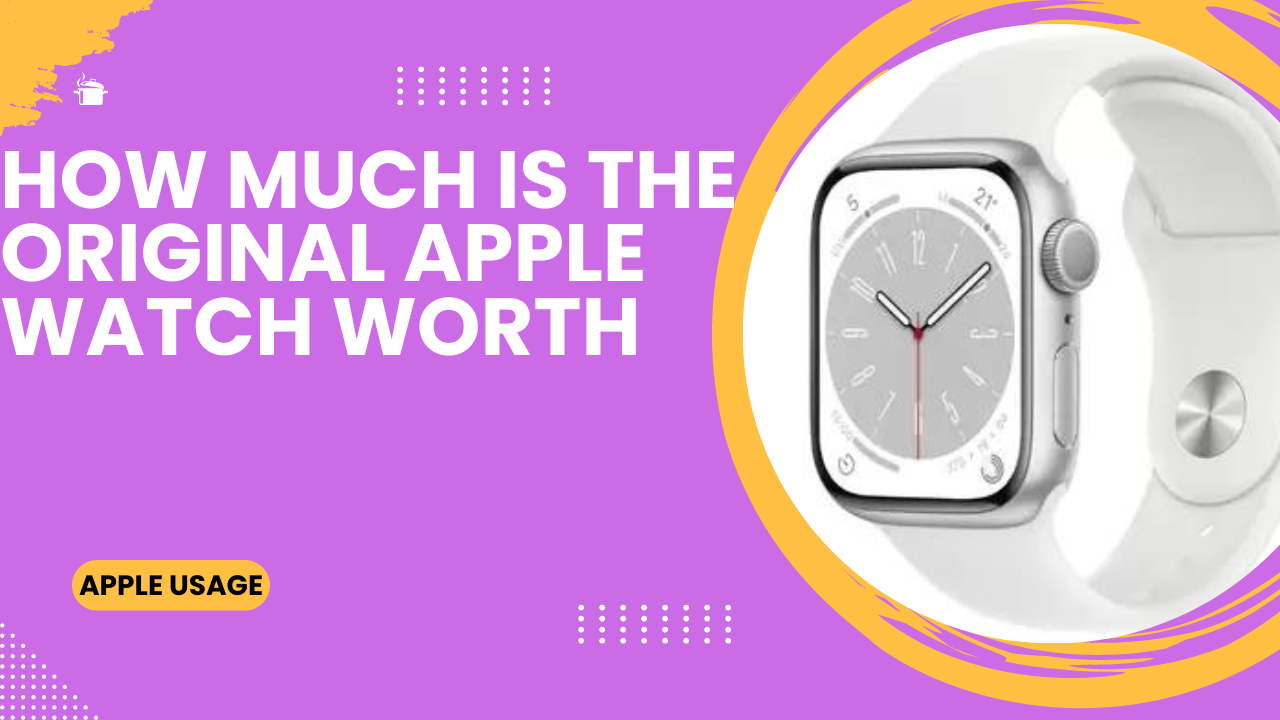Apple Watch has made itself a part of day-to-day life for many, making the transition of its array of features so smooth to use. But, just like any other electronic device, battery power is its lifeline. One important factor in keeping your Apple watch working all day is to figure out when to charge it. How Often Charge Apple Watch are;

The Different Factors That Contribute to The Battery Consumption in Apple Watch
Among the elements affecting the Apple Watch battery are the points below.
Screen Brightness:
The high-resolution Apple Watch display is great but also drains the battery. The stronger the brightness, the more power it takes. To increase endurance, reduce the brightness setting. You can use auto-brightness so that the watch can adjust itself to the ambient light around you or set a specific level that is not too bright.
Usage Frequency:
Not by chance that the battery of your Apple Watch becomes weaker the more you use it. Extended workouts with GPS-enabled continuous calls or always receiving notifications may cause the phone to run out of power more quickly. Take care to choose the functions that you use most during the day and adapt them to your needs.
Installed Apps:
Not only do third-party apps extend the functionality of an Apple watch but they also can be battery drainers. Not all apps are the same – some probably can be more active on the battery than others. Set a regular app checkup and weed off the ones you don’t use frequently from your watch. Besides, we can save the power of the battery when we update these apps.
Software Updates:
Apple released software updates for the Apple Watch often including battery life optimizations. New improvements will be made to your watch anytime the software is updated, to your benefit. Similarly, bugs that can drain the battery can be found in outdated software.
How Often to Charge Your Apple Watch Battery.
The ways below explain these kinds of charging your watches.
General Charging Guidelines:
The truth is, there’s no universal solution because it depends on how you use your devices. Apple said the promised run time of a battery charge is 18 hours when used for checking the time, receiving notifications, eating apps, and even having a workout. However, several factors can influence this.
Heavy users:
Charging may be daily or even more often if GPS tracking is used frequently, music streaming is involved, or you make several calls.
Light users:
Those majorly using their watch for standard notifications & clocking time may take charging every 2nd or even fewer days.
Tips for Extending Your Charge:
Here are some strategies to maximize your Apple Watch’s battery life between charges:
Optimize screen brightness:
Lower the screen backlight or switch on the auto-brightness to cut battery usage.
Manage notifications:
Cut off the meaningless messages or turn them off when you are of no use.
Control background app refresh:
Limit background app refresh only for less common apps to save battery.
Utilize Power Saving Mode:
Activate Power Saving Mode when battery life is low to maintain only critical functions.
Optimize workouts:
Think of doing workouts outdoors without your GPS for activities such as yoga or lifting.
Developing a Charging Routine Formulation
The plan for a charging routine will be structured as below;
Nightly Charging:
This is the single most popular method for a lot of Apple Watch users. Here’s why:
Convenience:
Every night just by placing your watch on the charger you ensure that it is fully charged and ready to use the next morning. No more being desperate for a charger when you have to leave in a hurry.
Long-Term Battery Health:
The nightly charge could be a full cycle charging that could help the battery retain its long-lasting condition. Deep discharges of the battery from top-up charging may accelerate its aging, compared to shallower charges.
Peace of Mind:
Having your watch fully charged in the morning flies out any concerns of spending the day without power, especially if you need running notifications or fitness tracking.
However, there are a few things to consider with nightly charging:
There are following ways are;
Potential for Overcharging:
The present-day Apple Watch battery has a design to prevent overcharging. But some users would like to not leave their watch on the charger for a long time.
Top-up Charging:
This method involves charging your watch on a few short cycles a day as necessary. Here are some potential benefits:
Reduced Wear and Tear on Charger:
A shorter charging time means less wear and tear on the charging cable or dock as well.
Flexibility:
Top-up charging is a convenience that you can adjust to your charge habit. You can charge it before exercise, at a meeting, or whenever an opportune time occurs.
However, top-up charging also comes with some drawbacks:
There are following tips are;
More Frequent Charging:
It may be that you will have to connect your watch to the charger more frequently to have higher battery levels. This can irk some of the users.
Potential for Battery Degradation:
Frequent shallow discharges might result in a more hastened process of battery capacity decrease than nightly charging.
Choosing the Right Routine:
It is impossible to find a charging plan that suits everyone’s needs or tastes.
Nightly charging is ideal for:
People who prefer comfort and extended battery life. The individuals who mostly rely on their watch and want to make sure it is always charged at full capacity.
Top-up charging is ideal for:
Those who are worried about the durability of the charger or who list flexibility on their top priority list. Users who have mere phone needs don’t care much about the charging frequency.
Battery Health Considerations
There are a few options to check the health status of battery performance:
Battery Aging: A Nature Process
Similar to every rechargeable battery, the Apple Watch also degrades with time. Such a natural chemical process originates from cycling the cells. As the battery grows older, its capability to retain a charge declines; hence battery life is gradually reduced.
Factors Affecting Battery Health:
Several factors can influence the aging rate of your Apple Watch battery:
Charging habits:
Regular partial charges, when the battery is not deeply depleted before it is charged, might lead to faster deterioration than when full charge cycles are used.
Extreme temperatures:
Battery aging increases with exposing the watch to very hot or cold temperatures.
Usage patterns:
- During a trip, using features like GPS, cellular connectivity, and screen brightness can consume power faster.
- Monitoring Battery Health on Your Apple Watch:
- Fortunately, your Apple Watch provides tools to monitor its battery health:
Battery Health percentage:
This term shows in the Settings app and indicates the maximum capacity of the battery compared to when it was new. This is a reflection of lessened capability.
Optimized Battery Charging:
This feature learns your charging pattern and delays the last stages of charging until a while before you usually get up. It might help the battery life become longer.
Maximizing Battery Life and Health:
Here are some tips to extend your Apple Watch battery life and health:
Maintain a regular charging routine:
Complete cycles need to be done nightly if you want your battery to last.
Avoid extreme temperatures:
Avoid leaving your watch in direct sunlight or very cold places for a long time.
Optimize brightness and settings:
Change the brightness of your screen, and turn off features like an always-on display that will consume the battery.
Enable Optimized Battery Charging:
It can make the battery stress-free during the charging cycles.
Screen Brightness
These are the screen brightness details that adversely affect the battery juice.
The Brightness-Battery Life Connection:
The display of the Apple Watch is exactly beautiful, but on the other hand, you also have to pay for its brightness. The brighter the scene, the more power it takes to reach this level of light. It, in turn, means a faster discharge of your watch battery.
Finding the Right Balance:
The solution is the right proportions of screen visibility and battery consumption. Here’s how adjusting brightness settings can help.
Lowering Brightness:
The simplest way of saving the battery life is to turn off the display brightness. Our eyes will notice even a small vision loss, be it inside or in a low light condition.
Auto-Brightness:
Use the auto-brightness feature. This one automatically adjusts the screen brightness depending on the light around it. It makes the display’s visibility optimal while maintaining low power consumption.
Optimizing Brightness for Different Scenarios:
Here are some tips for adjusting brightness based on your situation:
For everyday use:
Take caution to avoid excessive brightness indoors. This is usually unnecessary unless you are on a sunny day.
During workouts:
For instance, a sport like running and cycling may require a slightly brighter display so that the visibility is better. By and large, if you are mainly using indoor gym equipment, you can afford to set it at a lower value.
At night:
Use low screen brightness for nighttime use of the watch to minimize screen glare and conserve battery when you sleep.
Beyond Brightness:
Not only brightness, consider that other features like contrast could degrade your battery life. Think of deactivating features like “Always On” mode, which permanently turns on the screen, to save more battery.
Typical Charging Guidelines in General Therefore
The following factors would include:
Frequency Recommendations:
As Apple claims, the battery of the Apple watch can last 18 hours on a single charge with normal use. However, this can vary depending on several factors, including:
Usage patterns:
Such features as GPS, cellular data, or constant workouts give a heavy battery drain.
Screen brightness:
A brighter screen draws more energy.
Installed apps:
With these factors in mind, here are some general charging frequency recommendations:
Heavy users:
With regular GPS tracking, music streaming, and calls, you might need to recharge it every day or even more often.
Moderate users:
A recharge once every two days may be enough if you primarily use your watch for notifications, timers, and simple fitness tracking.
Light users:
But if you use only your watch for notifications or time checks casually, then possibly charging every few days will be fine.
Convenience vs.Battery Health:

The best charging habit achieves both convenience and longevity of battery performance. Here’s a breakdown of the two approaches:
Finding the Right Balance:
In the end, the right charging regimen is the one that works for you. Here are some tips to find your sweet spot:
Pay attention to your usage patterns:
Keep your eye on the battery level and see how long it will go with your current schedule.
Experiment with charging methods:
If possible make a trial of nightly charging as well as top-up charging to identify which one you find more suitable.
Prioritize battery health if needed:
If you worry about battery longevity, try charging it daily with full cycles when you have to.
Maintaining the most life out of the battery can be summarized as follows: 1. Undertake a Full Charge Routine 2. Avoid Heat 3. Turn off the Screen Saver Function
The below tricks concerning battery life are as:
With your battery at its lowest point and you need to go a few more miles, activate Power Reserve mode. The trainer mode cuts down on functionality as it only shows the time, saves most of the attributes, and allows for basic workout tracking.
Swipe up on Control Center from a watch face.
- Click the battery icon here.
- Select “Power Reserve.”
Power Reserve is a lifesaver in situations like:
- A long ride home with a low battery.
- Keeping the juice for further training.
Knowing you’re not going to able to recharge your device for several hours.
Airplane Mode: Flying out of Battery Canceler:
A board strategy that works well is using Airplane mode. This type of mode turns off the cellular connection, WiFi, and Bluetooth, hence, minimizing battery usage. Here’s when Airplane mode can be beneficial:
In areas with weak cellular signal:
For example, with airplane mode, the watch won’t be trying to search for a signal as it will be in the off mode.
During workouts indoors:
When you exercise on a treadmill where you do not need cellular or Bluetooth connectivity, Airplane mode can save your battery from unnecessary discharge.
At night while sleeping:
Airplane mode negates powering up data connections but instead charges enough juice for the morning.
But remember to turn Airplane mode off when you need services again.
Bonus Tip: Spit out Background App Refresh:
A lot of apps never stop streaming data all the time, even when you are not using the software. It can lead to power loss.
- Open the Watch app on your iPhone.
- Proceed to “General” -> “Background App Refresh.”
- Select the apps you want to simultaneously use and the ones you don’t need right now.
Conclusion:
The key to the proper functioning of your Apple Watch is knowing the right time to charge it. Accounting for your usage patterns, charging behaviors and battery status will allow you to extend the use of your Apple Watch without any interruption during the day.
FAQs:
There are following FAQs are;
Q1: How long does the Apple Watch take to fully charge?
The full charge time of the Apple Watch depends on the model and charger. Based on the average, that is 1.5-2 hours to charge from 0% to full.
Q2: Do I have to plug in my Apple Watch for the whole night?
Yes, leaving the Apple watch charging overnight is secure and freeing as well. The charging process is specific to preclude overcharging and provide security for the battery’s health.
Q3: Can I use my Apple Watch which is charging?
Yes, the Apple Watch can be used even when it is charging up. While so, these features add to the loading time.
Q4: Why does my Apple Watch see a fast battery drain after a software update?
As an Apple Watch updated, the background processes will take place that will probably result in excessive battery drain. This is normal later on as the body gets used to the change.
Q5: Should I charge my Apple Watch to 100% every time?
However, you do not need to charge your watch to 100% every time. Doing so occasionally will help make the battery meter more accurate.





